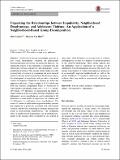Unpacking the relationships between impulsivity, neighborhood disadvantage, and adolescent violence : an application of a neighborhood-based group decomposition
Abstract
Scholars have become increasingly interested in how social environments condition the relationships between individual risk-factors and adolescent behavior. An appreciable portion of this literature is concerned with the relationship between impulsivity and delinquency across neighborhood settings. The present article builds upon this growing body of research by considering the more nuanced pathways through which neighborhood disadvantage shapes the development of impulsivity and provides a situational context for impulsive tendencies to manifest in violent and aggressive behaviors. Using a sample of 12,935 adolescent from the National Longitudinal Study of Adolescent to Adult Health (Add Health) (mean age = 15.3, 51% female; 20% Black, 17% Hispanic), we demonstrate the extent to which variation in the association between impulsivity and delinquency across neighborhoods can be attributed to (1) differences in mean-levels of impulsivity and violence and (2) differences in coefficients across neighborhoods. The results of a series of multivariate regression models indicate that impulsivity is positively associated with self-reported violence, and that this relationship is strongest among youth living in disadvantaged neighborhoods. The moderating effect of neighborhood disadvantage can be attributed primarily to the stronger effect of impulsivity on violence in these areas, while differences in average levels of violence and impulsivity account for a smaller, yet nontrivial portion of the observed relationship. These results indicate that the differential effect of impulsivity on violence can be attributed to both developmental processes that lead to the greater concentration of violent and impulsive adolescents in economically deprived neighborhoods as well as the greater likelihood of impulsive adolescents engaging in violence when they reside in economically disadvantaged communities.
Citation
Vogel , M & Van Ham , M 2018 , ' Unpacking the relationships between impulsivity, neighborhood disadvantage, and adolescent violence : an application of a neighborhood-based group decomposition ' , Journal of Youth and Adolescence , vol. 47 , no. 4 , pp. 859-871 . https://doi.org/10.1007/s10964-017-0695-3
Publication
Journal of Youth and Adolescence
Status
Peer reviewed
ISSN
0047-2891Type
Journal article
Description
The research leading to these results has received funding from the European Research Council under the European Union’s Seventh Framework Programme (FP/2007–2013)/ERC Grant Agreement no. 615159 (ERC Consolidator Grant DEPRIVEDHOODS, Socio-spatial inequality, deprived neighbourhoods, and neighbourhood effects); and from the Marie Curie programme under the European Union’s Seventh Framework Programme (FP/2007–2013)/Career Integration Grant no. PCIG10-GA-2011-303728 (CIG Grant NBHCHOICE, Neighbourhood choice, neighbourhood sorting, and neighbourhood effects).Collections
Items in the St Andrews Research Repository are protected by copyright, with all rights reserved, unless otherwise indicated.

